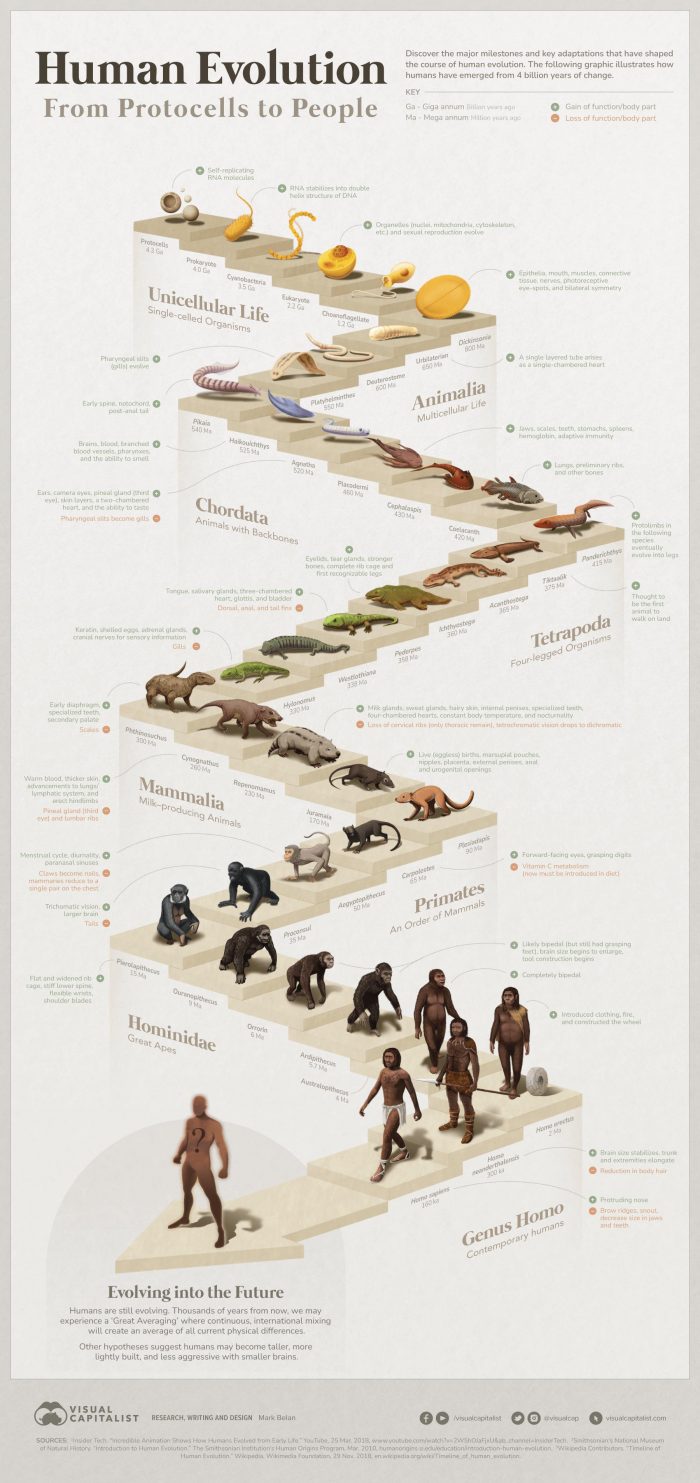
In this article, we’ll explore the evolution of man from the beginning of life on Earth until the present day. We’ll cover the four stages of earth’s history and how they relate to our species’ development as well as what happened during each stage. Finally, we’ll look at some key events that led to humans becoming who they are today.
Protocells
Protocells are the first life forms. They were made of organic molecules and were not able to reproduce themselves, metabolize or respond to their environment.
Unicellular Life
Prokaryotic cells are the simplest type of cell, and they are made up of just one membrane. They have no nucleus or other organelles; their DNA floats free in the cytoplasm. Eukaryotic cells, on the other hand, have several different compartments that contain different types of molecules (such as proteins). These compartments are called organelles:
- Nucleus: Contains your DNA and is where new protein synthesis happens
- Mitochondria (plural): Produce energy for your body through respiration; they also contain DNA!
- Ribosomes (plural): Make all the proteins that you need for growth, development and function
Animalia
Animals are multicellular eukaryotes that are heterotrophic, meaning they obtain their nutrients by feeding on other organisms or organic matter. They have a digestive system, nervous system, excretory system and reproductive system. Animals also have respiratory organs such as gills or lungs to absorb oxygen from the air they breathe.
- Multicellular means many cells in one organism
- Eukaryotic means cell nucleus with chromosomes inside it
- Heterotrophic means able to get energy by consuming other organisms for food
Chordata
Characteristics:
- Have a notochord, dorsal nerve chord and pharyngeal slits.
- Includes fish, amphibians, reptiles, birds and mammals.
Size: The largest group of animals (over half of all living species).
Tetrapoda
Tetrapoda is the earliest major group of animals with backbones to evolve. It includes amphibians, reptiles, birds and mammals. The first tetrapods are known as amphistium. These creatures had legs but still spent most of their time in the water. The first true tetrapods were tiktaalik which had lungs so they could breathe on land and fins for swimming in water!
Mammalia
Mammals are warm-blooded, hair-covered animals that have four limbs. They give live birth and possess mammary glands to nourish their young. Mammals are vertebrates (animals with backbones). The earliest mammals appeared about 200 million years ago, during the Triassic period. They resembled small shrews or mice and were nocturnal hunters of insects and other tiny animals that could be found in woodlands near rivers or lakes. During this time period, reptiles dominated terrestrial environments for millions of years before being replaced by mammals around 65 million years ago when dinosaurs went extinct due to an asteroid strike on Earth’s surface that created a massive dust cloud blocking out sunlight from reaching our planet’s surface–a process known as planetary cooling!
Primates
The first primates are thought to have appeared in the early Cretaceous period, around 100 million years ago. They were small and rodent-like, but they had already developed many of the characteristics we associate with modern primates: intelligent social behavior; binocular vision (the ability to see objects using both eyes at once); opposable thumbs for grasping branches; and a large brain relative to their body size. Primates are mammals that belong in the order Primates, which contains two suborders: anthropoids (monkeys) and prosimians (lemurs). Anthropoids include monkeys, apes, humans and tarsiers; prosimians include lemurs (which live only in Madagascar), lorises and bush babies.
Hominidae
Hominidae is a family of primates. The family includes the genera Pan (chimpanzees), Gorilla, Pongo (orangutans), and Homo. Homo is also known as “human beings”, and it is the only living genus in the family Hominidae. It can be divided into two subgenera: Homo sapiens and Homo neanderthalensis.
Genus Homo
The genus Homo is a diverse group of species that includes modern humans, extinct human ancestors and relatives. The first species in the genus was Homo habilis. This early hominid lived between 2 million and 1.5 million years ago in Africa and had a brain size that was about 50% larger than Australopithecus afarensis (another early hominid). Homo erectus appeared around 1.8 million years ago, with fossils found in East Africa, Georgia and Indonesia among other places; these were taller than earlier humans but still relatively small-brained compared to us today (around 40% larger than A. afarensis). They were also capable toolmakers who may have used fire for cooking food as well as heating shelters during cold weather conditions
Evolution is a constant process, and it has been since the beginning of life on Earth. From single-celled organisms, humans have evolved into intelligent beings with complex social structures and languages. The next stage in our evolution may very well be the creation of artificial intelligence that surpasses our own capabilities. While it’s hard to predict how far this process will go before we reach some sort of plateau or equilibrium point, it seems clear that Homo sapiens will continue to evolve for as long as there are human beings left on Earth–and possibly beyond! We have come a long way from the first protocell to human beings, but we will continue to change as time goes on.
